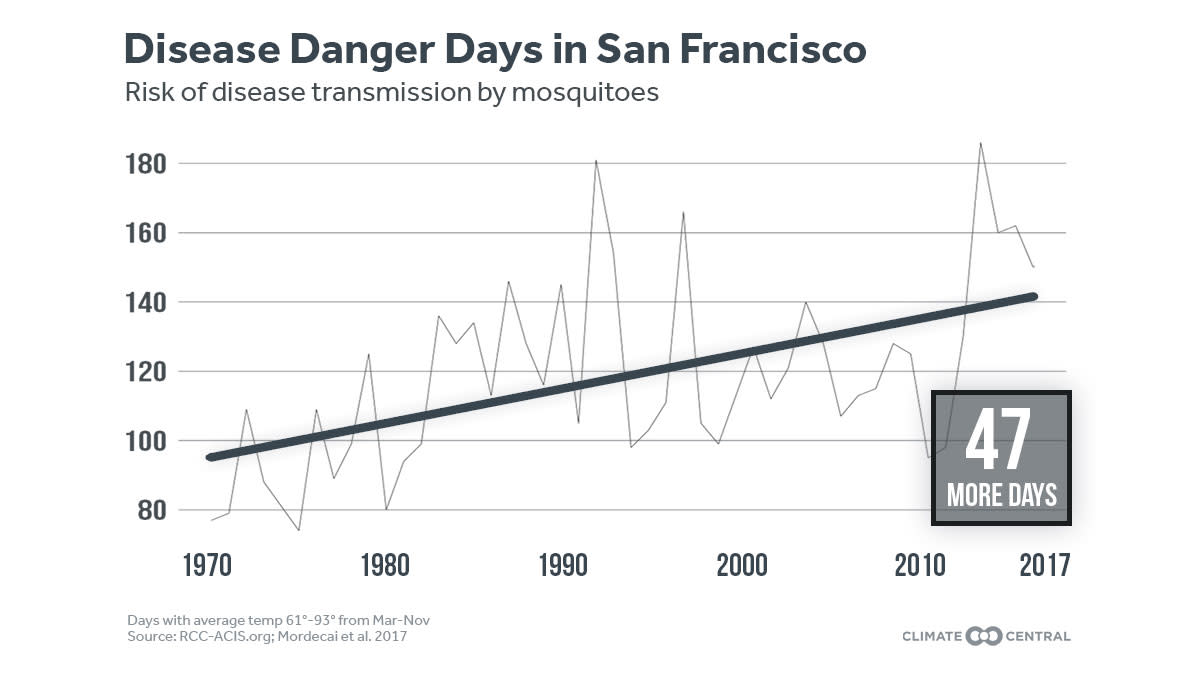KEY POINTS
Pests like mosquitoes, ticks thrive in a warming world
New report: Most cities see jump in mosquito “disease danger days”
CDC calls infectious diseases transmitted by a bite from infected pests like ticks, mosquitoes or flies a large and growing concern
Scientists say climate change fingerprints can be found on the extreme heatscorching Europe this summer and the deadly wildfires now torching Northern California. Another lesser-known but still potentially deadly result of human-caused climate change is the increase in certain diseases transmitted by mosquitoes, ticks, flies and other carriers known as vectors. These vector-borne diseases (VBD) include dengue, West Nile and Zika viruses and Lyme disease.
VIEW REPORT
Ticks and mosquitoes like heat. Rising global temperatures can increase the geographic regions vulnerable to the bites from these insects, as well as lengthen the season when the pests are infectious. An elevated risk of disease transmission from mosquitoes exists when temperatures are between 61 degrees and 93 degrees Fahrenheit. In its new report U.S. Faces a Rise in Mosquito ‘Disease Danger Days’, Climate Central analyzed the number of days with temperatures in the risk zone during spring, summer and fall for 244 cities across the country. The analysis revealed 94 percent (229 cities) have an increasing number of these “disease danger days.”
You can find the complete report here, including a ranking of the cities with the greatest change in number of danger disease days. Of the possible 275 days analyzed for the report, Honolulu and San Juan fall in the disease transmission zone for the entire stretch.
“Climate change poses about the largest health impact that there can be,” said Dr. Jonathan Patz, director of the Global Health Institute at the University of Wisconsin-Madison. “Any disease carried by mosquitoes, or ticks — these cold-blooded insects are very sensitive to just small changes in temperature and humidity — is likely to be affected by climate change. While some diseases actually will decrease because it will get too hot in areas for certain ticks and mosquitoes, overall the negative effects of climate change on vector-borne diseases far out way any positive effects."
Deer ticks spread Lyme disease, which makes up nearly two-thirds of the vector-borne diseases in the United States. Lyme disease is spreading in the Northeast and Upper Midwest, with more deer ticks there in a warming world.
Ticks are not just pests, they also carry diseases. See the full multimedia package on tick migration.
A report issued in May by the Centers for Disease Control and Prevention (CDC) estimated 300,000 Americans become infected by Lyme disease each year and called vector-borne diseases here in the U.S. a large and growing public health problem.
Climate Central produced a story about our new findings in partnership with with the El Paso Times focusing on El Paso, where residents are vulnerable to West Nile virus spread by Culex mosquitoes. You can read it here.
FOR MORE INFORMATION:
